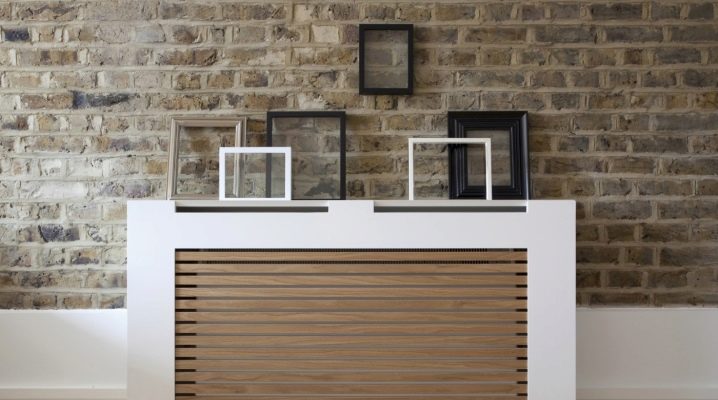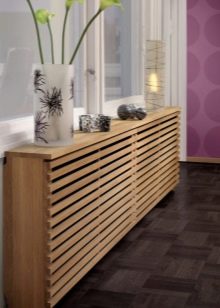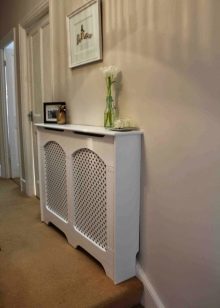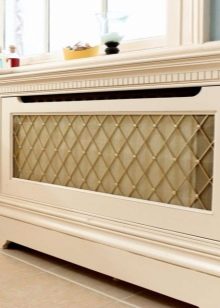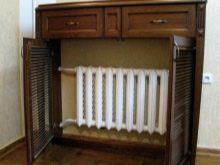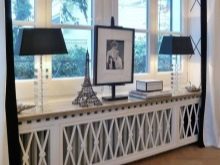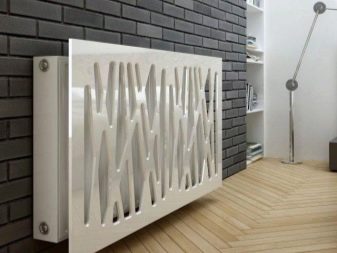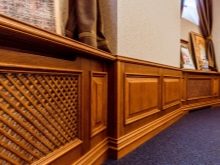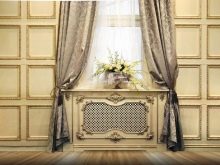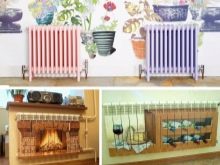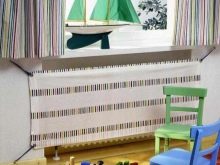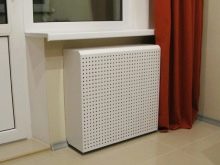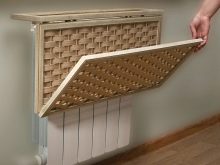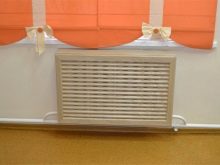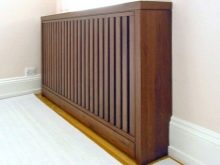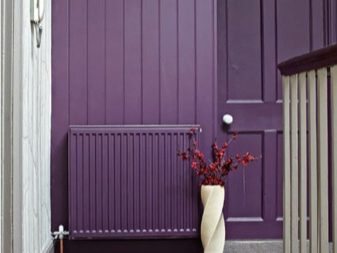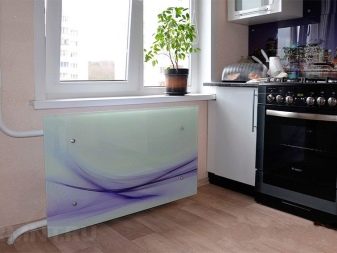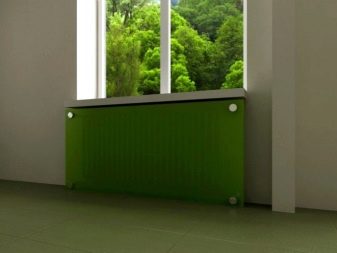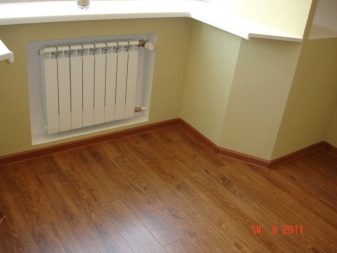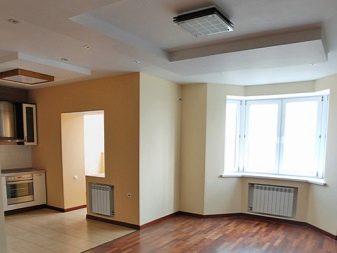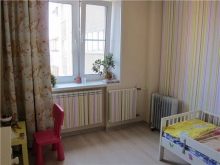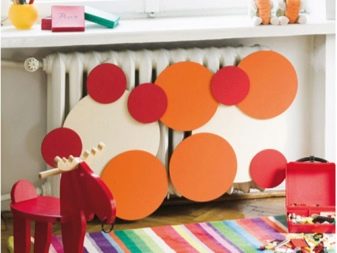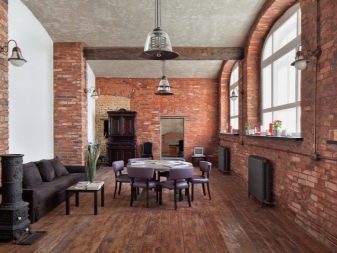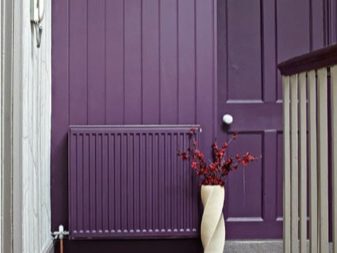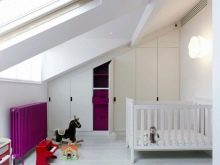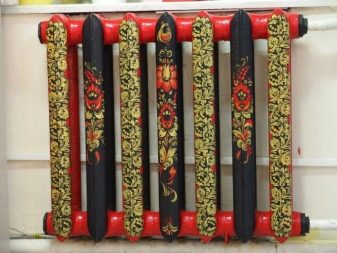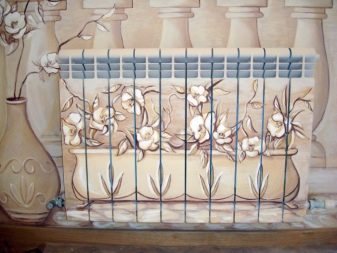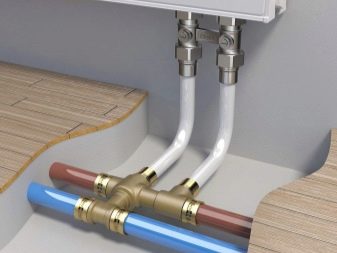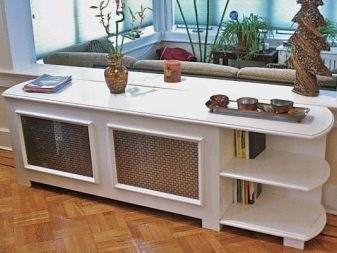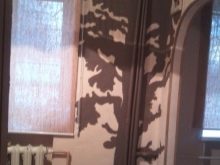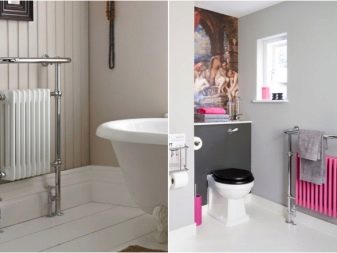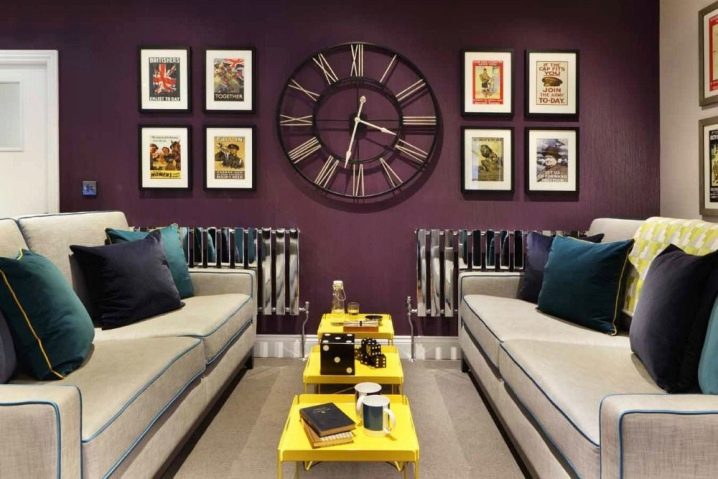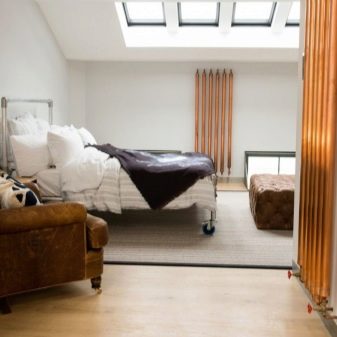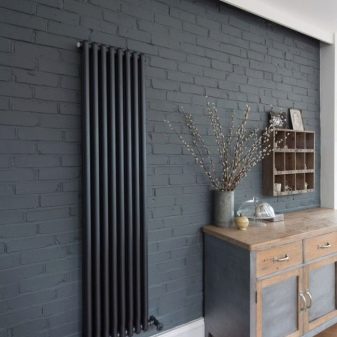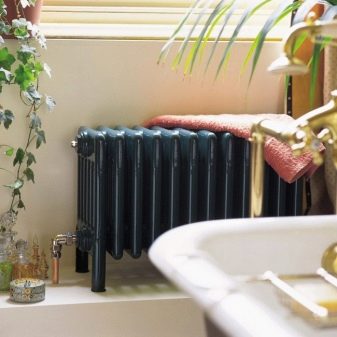How beautiful and correctly hide the radiators?
Heating batteries can not always serve as an interior decoration. Therefore, they have to hide, decorate in all possible ways. Let's try to figure out how to do it beautifully and correctly.
Features and requirements
Decorating heating radiators is not such an easy task as it may seem at first glance. It is necessary not only to hide an unsightly radiator, but also to maintain a comfortable temperature in the room. It is obvious that closed batteries provide much less heat, and access to them becomes difficult.
In order to properly close the batteries and not reduce the heat exchange (or at least reduce slightly), it is necessary to understand how the radiators heat the room, on what basis they work.And choose the decor so that it represents the minimum interference with the battery performance of its functions.
For this, removable or side screens that do not have solid fasteners are well suited. This is necessary so that the radiator can be accessed at any time. Such a need may arise unexpectedly, and if the battery is mounted in a wall, a plasterboard box or closed with a screen “tightly” attached to the wall, the structure will have to be broken. Remove it without damage will not work.
Another important criterion when choosing a decor is how much it affects the heat transfer. The heating of the room occurs due to the emission of infrared radiation (it heats objects) and convection (it heats the air directly).
Solid screens, devoid of gaps from the bottom and top, will be a serious obstacle for the first and second. The best option would be perforated, carved or louvered screens that do not cover the battery from either the top or bottom. Either closing slightly.
In order for the air to warm up evenly, it must be able to freely enter from the bottom of the battery, pass through it, and exit from the top already warm. A tightly “sealed” radiator does not give him that opportunity, and therefore the temperature decreases.As for infrared radiation, it simply cannot pass through a solid, impenetrable screen that provides almost one hundred percent heat insulation of a battery.
Recently it can be seen that batteries are often covered with glass photo printing screens. Of course, this solution has high decorative properties, however, the temperature in the room, equipped with this decor, drops significantly.
The best solution for any interior would be a wooden perforated or carved screen. The main thing is to have as little as possible a solid surface and as many holes as possible, allowing air to circulate freely. In addition, the tree harmoniously fits into almost any style of interior, you need to highlight such a property as environmental friendliness. When heated, it will not emit any harmful substances. On the contrary, under the influence of heat, wood emits essential oils that have a positive effect on human health (of course, we are talking about natural wood).
Economical ways
To hide old radiators, it is not at all necessary to use expensive materials and structures.There are many budget ways to close unsightly radiators, while maintaining high heat transfer rates and easy access to the system.
These methods include:
- Coloring. Even old, Soviet battery samples can be turned into a stylish interior element by painting them to match the walls or, alternatively, in a contrasting color. The costs are minimal and the benefits are obvious: the possibility of quick access to the radiator remains, convection is not difficult, the room temperature remains at a comfortable temperature. Such radiators will fit into any interior, from the modern loft to the classics, the main thing is to choose the right color.
- Textile. The simplest thing is to close the batteries with curtains that go down to the floor. The main thing is to make sure that there is no possibility of fabric ignition from too hot batteries. Or - if the option with curtains is not quite acceptable - you can stretch a fabric on the wooden frame that is in harmony in color with all the other textiles in the room, and close the radiators with this screen. The air passes through the fabric easily, it does not represent any obstacle to this, and hence the heat transfer will not decrease.
- The use of materials such as plastic, MDF panels, and drywall will also be inexpensive. However, they have a significant drawback - lowering the heat in the room. Yes, and in terms of environmental friendliness, these materials leave much to be desired. The same plastic, for example, is better to use in the bathroom to close the tap in the kitchen, that is, in rooms with high humidity, where the same wood, the same metal will quickly become unusable due to external factors. A box of MDF panels or drywall has good thermal insulation properties, which in this case is absolutely not necessary. Yes, and get to the system will be difficult.
Of course, low cost is a significant material advantage, and for many it is decisive. However, one should not forget that its main function is to ensure not only the aesthetic appeal of the heating system, but also heat in the apartment. Therefore, rely solely on the price still not worth it.
Wooden structures have a good combination of availability, aesthetics, environmental friendliness and the ability to transmit heat. A simple grille of narrow slats, which are sold in any hardware store, can effectively hide radiators and will not interfere with their normal operation.In addition, this solution will look organic in any interior. No wonder the tree since ancient times was used in the design of houses. His peculiar natural aesthetics, warmth, comfort, which it brings into the house, are valued and in demand until now.
If you choose a metal sheet - copper or aluminum - as a background for a carved wooden panel, this solution will be of double benefit. The tree will take over the decorative function, and thanks to the metal, the temperature in the room will not only not decrease due to the closed battery, but may even increase.
Popular solutions
Currently, there are many ways to hide old cast iron batteries under the window. Screens of a wide variety of materials, niches, painting, wall mounting - options for every taste. But if you decorate heating radiators in the living room, bedroom or nursery, it’s quite simple - just choose a solution that will be in harmony with the general style of the interior - in rooms with characteristic conditions (for example, in the kitchen, bathroom) - it is more difficult to do.
For these rooms it is necessary to choose a material that will withstand high humidity., and temperature drops, and the possible effects of steam, chemicals. And with all this will be non-toxic. The best option would be to paint the radiators to match the walls or in contrast with it. This way to decorate pipes - the most common in bathrooms.
As for the other rooms of the house, it all depends solely on the imagination and budget of the owners. But the basic requirements for screens for radiators must be met in any case. After all, their main task is to hide the unsightly elements of heating without sacrificing heat transfer. Therefore, any screen should provide free air circulation and infrared radiation. At the very least, create minor obstacles.
Now popular glass screens, of course, have a high decorative effect., look great in the interior, but they significantly reduce heat transfer, and therefore contribute to lowering the temperature in the room. This decor can be used if heating is carried out in any other way, for example, with the help of warm floors.
Quite often, such a solution can be found - the radiators are mounted inside the wall, and a small window (or two), closed by a grill, is left for the passage of heat.Not only that in this case the temperature in the room drops significantly, so also access to the system becomes almost impossible - for this you have to break the wall in the truest sense of the word.
The same applies to the boxes of drywall, plywood, MDF, chipboard and other similar materials. Decreased heat transfer, difficult access to the system against decoration. Everyone makes a choice for himself.
Gaining popularity now screens made of metal - copper or aluminum. Such models will not only not be lowered, but may also increase the temperature in the room. Heating up from the radiator, such screens themselves perform the role of a battery, and additionally heat the room.
If the room is covered with wallpaper - heating elements can be decorated with remnants. Cutting them into strips and sticking to the radiators (of course, heat-resistant glue), you can get an excellent decorative element at minimal cost that will harmoniously fit into the interior.
In the children's room in general, you can give free rein to the fantasy, and you can attract the inhabitants of the room to the process. Children will gladly take up the decoration of their own home and tell themselves how they would like to decorate the batteries.Favorite cartoons, fairy tales, own imagination, in which the room is not a room at all, but a ship, tank or racing car. All this can be used in the decoration of radiators.
Designer Tips
In order to decorate old heating radiators, it is not necessary to spend a large amount of money, effort and time. You can just paint them. Freshly painted batteries will look good in a modern interior, such as, for example, a loft, and in a classic, and in a soft-pastel room. The main thing - to choose the right color.
The same loft is an industrial style, and its color range is appropriate. The most commonly used black or white color. One of them can be used to paint the batteries. Elements painted in a contrasting color — black on white or white on a black background — will look particularly impressive.
For more prosaic, quiet interiors, this is hardly suitable - after all, he still emphasizes the heating system, distinguishes it, and not hides it. In an industrial loft, this is what you need. But, for example, in the classic interior it will be inappropriate. Here it is better to paint the batteries to match the walls so that they blend into the background.
Heating radiators can be decorated with painting. Such elements will look good in the nursery, emphasize the dynamic, active, unusual atmosphere inherent in this room.
In the bathroom, you can remove the pipes in a plastic box. In this room, it will be irrational to use wood or metal - materials will quickly become unusable, and the design will have to be changed. And plastic can easily endure the increased humidity of this room. However, for the kitchen, plastic will not work, it is better to give preference to traditional materials.
The decor of the heating system involves not only masking its elements, but also the possibility of easy and quick access to any of its nodes. This is one of the most important selection criteria that should be followed when choosing the design of radiators.
Another important factor is heat transfer. But here you can resort in a little trick. Foiled foamed heat insulator hung on the wall behind the battery will reduce heat loss by a factor of twenty.
But it should be precisely attached to the wall, and not just put the battery. At the same time, a distance of at least two to three centimeters must remain between it and the piece of insulator.
It is not advisable to close the elements of the heating system with boxes, hide them in niches or mount them in walls. If another option is not possible - it is necessary to provide the box with a door in order to ensure the fastest and easiest access to the system at any time.
Modern industry produces heating radiators that are significantly different from the Soviet models that everyone is so eager to hide or change. These are not only strictly geometric white radiators. It can be models of almost any shape and size. Such batteries do not have to be hidden or closed, on the contrary, they are usually put on display, hang up in the center of the wall and show the guests as a bright unusual accent.
Modern radiators are an effective element of decor, attractive in itself. Even simple white models have their own aesthetics. They do not necessarily hide. They will perfectly cope with the role of not striking, but stylish decorative elements, which also perform a practical function - they heat the room.
Examples in the interior
It is nice to arrange or hide the radiators in the room so that they are not a “fly in the ointment” and do not spoil the whole look of the room, it’s not such a difficult task.Modern materials allow to solve this issue with minimal cost.
Vertical, horizontal, sectional, copper, cast iron - the modern market offers a wide variety of radiators for every taste.
In the nursery, the battery will look good bright, cheerful colors, for example, yellow - it has a positive effect on the nervous system and emotional state of a person.
New models, unusual for the eyes - vertical radiators. They are located on the wall vertically, can occupy the entire height from floor to ceiling. This element looks quite stylish and does an excellent job with its task - to maintain a comfortable temperature in the room.
In the bathroom you can place a wide radiator of a small height (resembling a bench). He will be able to perform not only his direct task, but also serve as a clothes dryer or towels. By the way, the dryer can be connected to the battery - you get an interesting combination, again performing several functions. Rational use of space and objects never hurts.
Chrome radiators look interesting and unusual.They will be a real highlight of the interior, immediately attracts the eye.
An interesting finish - with the help of chrome - brings into the interior some kind of freedom, emancipation inherent in bikers. They come to mind when looking at these sparkling designs.
Designer radiators will also decorate any interior. Unusual designs, forms, when looking at which is not immediately and realize that this is an element of the heating system, they become a bright accent, like a picture on the wall. Such batteries should not be hidden, on the contrary, they are put on public display, they emphasize with a contrasting background, they are placed in the center of the wall without any addition, so that nothing distracts attention from an unusual object.
Copper radiators - both vertical and horizontal - can also serve as a spectacular room decor.
Their design is not complicated, but they have such advantages as:
- High heat dissipation.
- Attractive color.
- Ease.
Pleasant for the eyes, low-key color of copper will be a worthy addition to the interior in any style.
Laconic black elements of the heating system will look good on the background of brickwork - white or gray.They can also be vertical or horizontal, in any case they will be attractive, spectacular, but at the same time - restrained element of the decor.
In modern interiors, it is more common to find heating radiators, paraded as an independent element of decor, than hidden in a box or covered with screens. Even cast-iron batteries, which many people recall about the Soviet Union, are now distinguished by an interesting design, unusual color solutions and high decorative effect.
Left open batteries do a better job of heating the room, nothing prevents either air circulation or infrared radiation. This means that the temperature in the room remains comfortable, objects and air evenly heat up, heat does not remain inside the box or niche, but is distributed indoors. And this is the main function of the heating system.
How to hide a radiator, see the next video.
